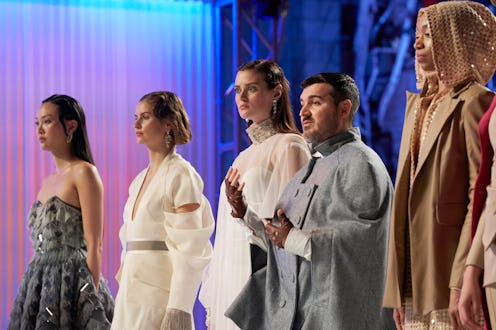
Since returning to Bravo last year, Project Runway has made a conscious effort to embrace inclusivity. And this season’s final fashion show reflected that mission.
In the Season 18 finale which aired Mar. 12, the final four contestants — Nancy Volpe-Beringer, Sergio Guadarrama, Victoria Cocieru, and Geoffrey Mac — made their way to Spring Studios to show during New York Fashion Week. As usual, each collection reflected a personal message that resonated with the designer’s aesthetic and vision. And two contestants chose to focus on the future of design, sustainability and inclusivity in particular.
Nancy Volpe-Beringer enlisted models of various sizes, gender identities, and abilities for her show, opening with a woman in a wheelchair. She explains to Bustle that inclusivity was always the plan for her final collection.
After an episode earlier in the season when designers worked with models of different abilities, she approached the producers and asked if she could use the same cast for the finale. With their support, she constructed custom garments to fit these women: A crystal-embellished design that was shorter on one side to be worn by a model with a prosthetic limb, a dress draped with a flat back for a wheelchair user.
“When I was selecting the models and we got together for the first [time], they all looked amongst themselves and they felt this inclusive energy that it wasn't just about wearing my clothes. They were a part of something [special].”
Volpe-Beringer’s collection was also entirely zero waste, a Project Runway first. “I saved all my threads on my serger...and I actually created like a wine tote [from them]. I up-cycled a plastic bag and I took a piece of vinyl and I quilted it with all my threads. And I up-cycled thrift store handbags.”
Elaine Welteroth, one of the judges and former Editor-in-Chief of Teen Vogue, was blown away by Volpe-Beringer’s designs.
“Nancy takes the notes seriously and applies them quickly, and I think that is what it takes to grow and evolve in this industry and stay one step ahead,” Welteroth tells Bustle. “I’m frankly floored by what she was able to pull off [with this collection]. The innovative use of fabrics was mind-blowing. It just looked like magic.”
Since joining the judges panel last season, Welteroth has been at the forefront of the show’s renewed commitment to inclusivity, which feels like a natural extension of the work she helped produce at Condé Nast before leaving in 2017.
“We need to move away from the mentality of thinking about inclusivity, diversity, and sustainability as ‘nice to haves’ and start to think of them more as must-haves,” she explains. “This is not a trend. This really is representative of where the fashion industry is moving and I think that each of these designers has proven that they have what it takes to be a part of the future of fashion.”
Another designer groomed by Welteroth this season was Sergio Guadarrama who also made sustainability a priority in his final collection. He began his part of the show by explaining his involvement with The Marine Arctic Peace Sanctuary, an organization founded to stop exploitation in the Arctic Ocean.
“All the fabrics I chose to use are up-cycled materials,” Guadarrama reveals. To find these materials, he goes to different manufacturers and collects their damaged or unused scraps, mending them into his designs. He cuts around the parts of the fabric that may be flawed. “We create 40% of all the waste settings and landfills within the fashion industry. So [in order] to not create more waste on the planet, I just use what we already have,” he says.
His handbags were made from kombucha he grew himself. “You're just using bacteria and it grows very rapidly and uses very minimal water and you just feed it honey and tea,” he explains. “And in a few months, you have something in a very solid state that you can turn into textiles or into accessories.”
Guadarrama’s runway show — which served drama and glamour, as is his signature style — was a clear representation of who he is as a designer and as an advocate.
“I went onto Project Runway to have a platform to discuss the things that I am very passionate about. We all need to be having these conversations, to learn something about what's really going on in the world, because all of them are honestly connected back to one thing, which is the greed of the planet.”